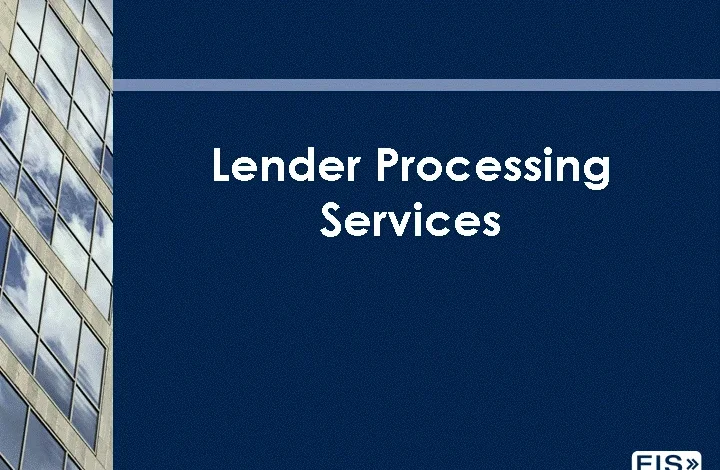Understanding “Lender Processing”: A Clear Guide for Borrowers and Institutions

What is Lender Processing?
Lender processing refers to the critical phase in the loan or mortgage lifecycle where the lender—and often their third-party service providers—collect and verify all documents, perform underwriting and prepare the file for final approval or denial. In the context of a mortgage, it lies between loan origination (application) and closing. According to the National Association of Mortgage Processors, loan processing includes steps such as verifying credit, verifying income and assets, checking property appraisal, and organising the file for the underwriter.
By understanding “lender processing”, borrowers and lenders can set realistic expectations about timing, responsibilities and potential bottlenecks.
Why Lender Processing is Crucial for Both Borrowers and Lenders
The lender processing stage is essential for several reasons:
-
It helps the lender manage risk, by confirming that the borrower meets credit, income, collateral and regulatory criteria.
-
For borrowers, it determines how quickly the loan will move forward toward closing, and influences whether further documentation is required.
-
Efficient processing means fewer errors, smoother underwriting, less chance of file return for correction—and ultimately a better borrower experience.
-
For lenders, optimised processing workflows (often via automation and outsourcing) can reduce operating cost, improve margins and increase capacity. For example, business-to-business services like Lender Processing Services (LPS) provided full lifecycle processing solutions to lenders
In short, lender processing is a key pivot point: if done well, the path to closing is smoother; if done poorly, the file may stall, causing delays, higher cost or even denial.
The Typical Workflow of Lender Processing
Here is a breakdown of the common steps within lender processing:
-
Application receipt & file creation – Borrower submits application and required data; file is opened.
-
Document collection & verification – Bank statements, tax returns, employment verification, credit reports, assets.
-
Data entry & file prep – Processor organises the loan file in the lender’s system, checks completeness.
-
Underwriting coordination – Once the file is ready, it moves to underwriting for decision-making on risk and compliance.
-
Conditional approval / conditions – Underwriter issues approval subject to conditions; processor ensures conditions are cleared.
-
Closing preparation – Final inspections, title work, loan documentation signings.
-
Funding & servicing hand-off – After closing, loan is funded and sometimes transferred to servicing.
It’s important to note that workflow can vary depending on loan type (personal, business, mortgage), lender size, internal vs external processing, and regulatory environment.
Common Delays, Issues & How to Mitigate Them
There are several frequent bottlenecks during lender processing:
-
Incomplete documentation or missing information – The most common cause of delay.
-
High application volumes – When rates fall or promotions occur, lenders may face a backlog which slows processing.
-
Regulatory and compliance checks – Additional steps are required in certain jurisdictions or for certain loan types.
-
Manual or legacy systems – Lack of automation can slow verification, tracking and file hand-off.
To mitigate these issues: -
Borrowers should prepare documents in advance, respond promptly to requests and follow up.
-
Lenders should adopt automation, workflow tools and clear file status tracking (e.g., intelligent document recognition).
-
Maintain transparent communication: lenders should keep borrowers informed of file status; borrowers should ask when they’re unsure.
By acknowledging these potential hurdles, all parties can plan better and reduce anxiety during processing.
Best Practices for Lenders & Processors to Enhance Efficiency
For lenders and loan processors looking to optimise their operations, the following best practices are valuable:
-
Automate routine tasks: Use software that extracts data, identifies missing fields, and routes tasks automatically.
-
Standardise checklists and workflows: A consistent processing checklist reduces variance, human error and file returns.
-
Monitor key metrics: Track file turn-time, clear-to-close rate, conditions per file, and rework rates.
-
Train and specialise staff: Specialised processors deeply familiar with loan types and regulations complete files faster.
-
Communicate early and clearly with borrowers: Clear expectations and status updates reduce friction and repetitive document requests.
-
Leverage outsourcing when appropriate: Outsourced services can help scale capacity and manage high volumes (as done historically by LPS).
By implementing these, lenders can turn lender processing from a necessary cost centre into a strategic capability that supports growth and customer satisfaction.
What Borrowers Should Know and Expect During Processing
As a borrower, here’s what you should keep in mind during the lender processing stage:
-
Response matters: When the lender asks for documentation (employment history, bank statements, credit info), respond quickly. Delays on your side become delays for the file.
-
Ask about turnaround times: Ask your loan officer what the average processing timeline is and what might delay the file.
-
Be organised: Keep all requested documents in one place. Avoid last-minute scrambling.
-
Understand statuses: Terms like “In processing”, “Underwriting review”, “Clear-to-close” all indicate different phases—knowing them helps you track progress.
-
Stay alert for changes: If your job, income, assets or credit changes during processing, inform the lender immediately (it may trigger new verifications).
-
Patience with complex loans: If you’re applying for a niche product, commercial loan or have a complex credit situation, processing may take longer.
If you approach the processing phase proactively and with realistic expectations, you’ll reduce stress and improve your chances of timely closing.
Frequently Asked Questions (FAQs)
Q1: How long does lender processing usually take?
A1: It varies. For mortgages, typical processing may take several weeks (often around 30-45 days), though simpler personal-loan types may process faster. Delays arise from document gathering, underwriting backlog or complexity.
Q2: What is the difference between lender processing and underwriting?
A2: Lender processing is the preparatory stage—collecting, verifying and organising the loan file. Underwriting is the next stage where risk analysis is performed and a decision (approval/denial) is made. Underwriting relies on a fully processed file.
Q3: Can lender processing be outsourced?
A3: Yes. Many lenders outsource parts of processing (document collection, verification, data entry) or use service providers like the former LPS to manage capacity and cost.
Q4: What does “file under lender processing” mean in my loan portal?
A4: It means the lender is working on verifying and preparing your loan file. It is still in process, and further information, underwriting or conditions may still be required.
Q5: What can cause a lender processing file to be returned or delayed?
A5: Missing or inconsistent documents, changes in borrower circumstances (job, income), discoveries during verification, or heavy pipeline volumes at the lender. Also, regulatory/compliance exceptions may trigger additional checks.
Q6: How can I help move lender processing along?
A6: Provide complete and accurate documentation early, respond to requests quickly, keep your employment/income stable, and maintain communication with your loan officer. Avoid making large financial changes (e.g., new credit, job changes) until after closing.
Conclusion
Lender processing is a vital bridge between the loan application and closing. Done well, it drives speed, accuracy and borrower satisfaction. Done poorly, it leads to frustration, delay and potential file fallout. Whether you are a borrower or a lender, understanding this stage—its workflow, pitfalls and best practices—gives you the power to manage it effectively. Armed with knowledge and realistic expectations, you can navigate lender processing with confidence and keep your loan journey moving forward.




